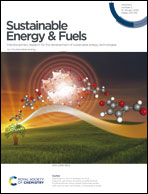Electrochemically promoted ammonia synthesis on an Fe/BaZr0.8Y0.2O3−δ catalyst at ambient pressure†
Abstract
Electrochemically promoted nitrogen reduction on solid-state electrolytes is a promising approach for synthesising ammonia (NH3) under mild conditions. In this study, yttrium-doped barium zirconate (BZY) was chosen as a solid-state electrolyte owing to its high chemical stability and NH3 production on an Fe/BZY catalyst was investigated under open-circuit conditions and polarised conditions in a N2–H2 gas mixture at 500 °C and ambient pressure. NH3 production was enhanced under applied voltages, and the highest production rate of 3.07 × 10−9 mol (s cm2)−1 was achieved under polarised conditions. The reaction rates were observed to change gradually as the reaction progressed, both in the open-circuit state and under applied voltages. This slow response of the NH3 production rate was modelled, and the electrochemical promotion of NH3 production was explained by the gradual removal of H adatoms from the catalyst and the resultant increase in N adsorption sites. The modelling result indicated that a higher ratio of adsorbed nitrogen atoms (N*) to adsorbed hydrogen atoms (Hs) contributed to accelerating the NH3 production rate.



 Please wait while we load your content...
Please wait while we load your content...